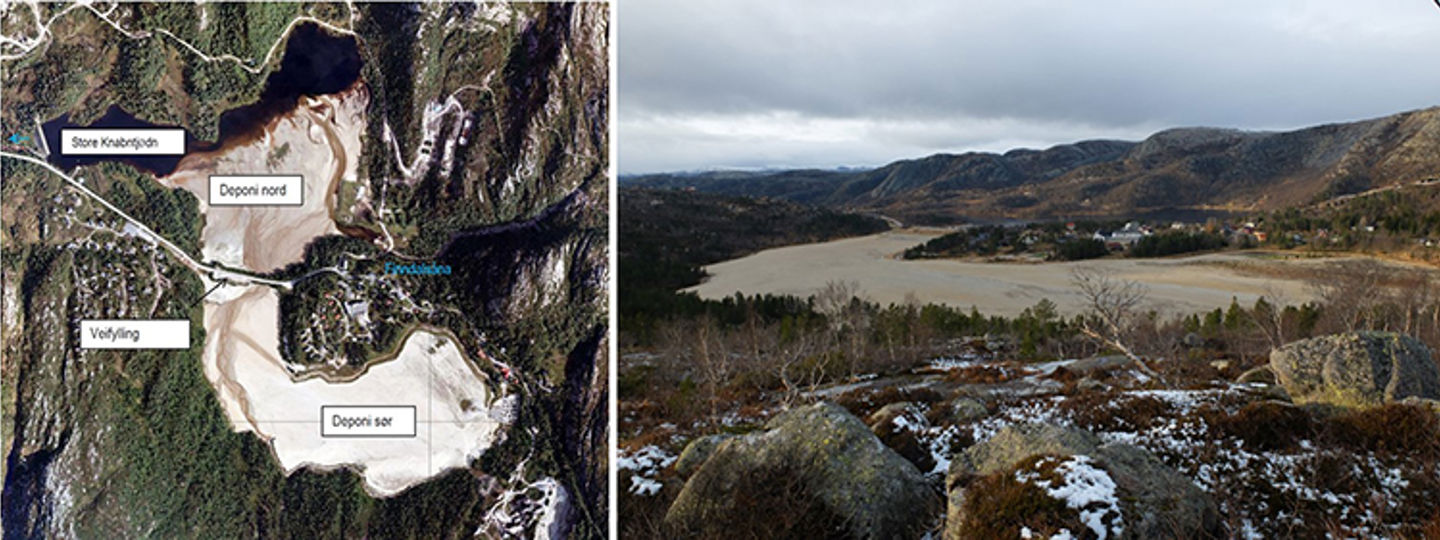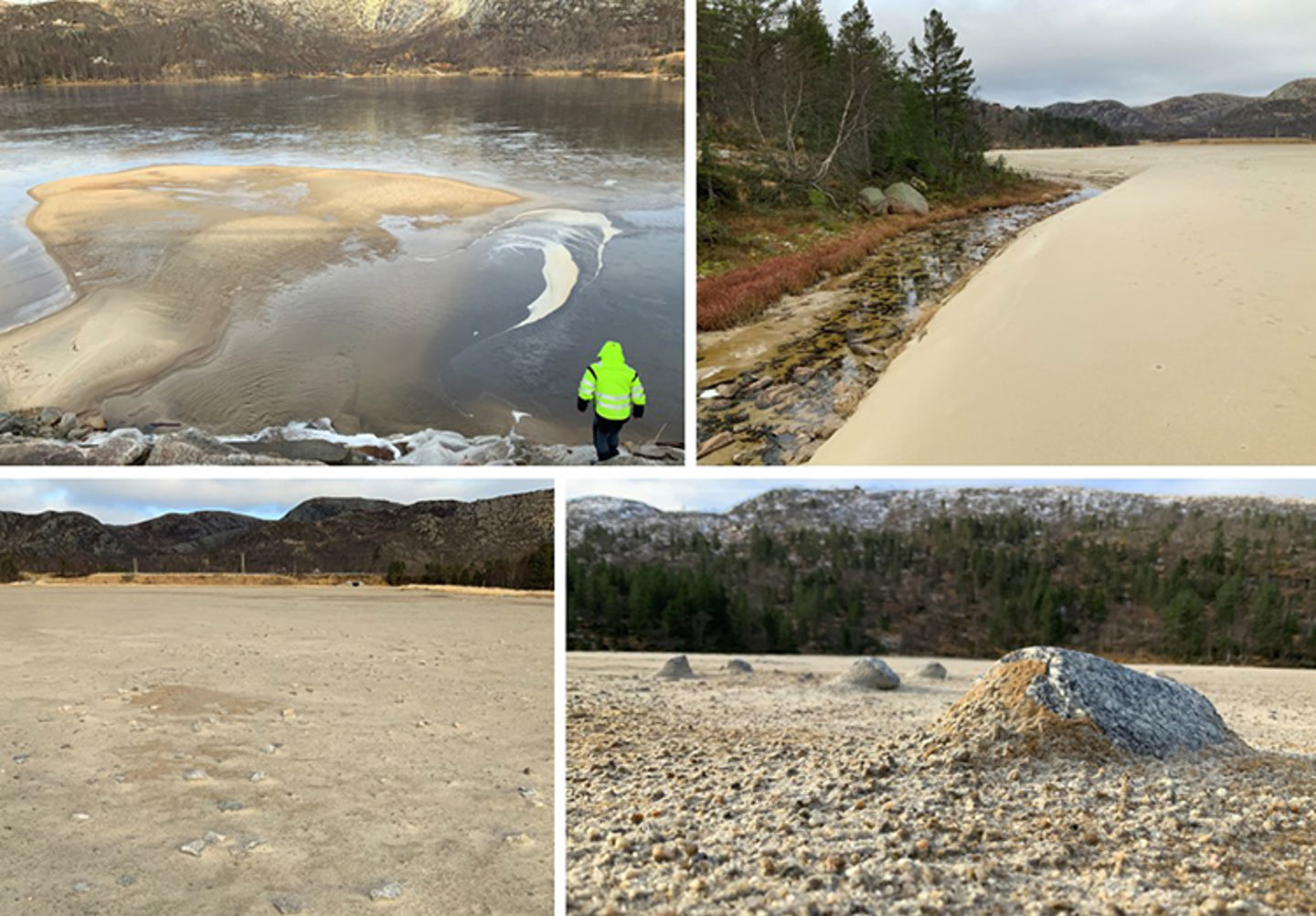Knaben mining landfill - status and measures
NGI has carried out an assessment of the status of the sand landfill after the closed Knaben Molybdenum mines in Kvinesdal municipality in Agder, Southern Norway. An assessment has also been made of possible measures to secure the landfill against mass flight, ie transport of sand masses by water and wind.

NGI has inspected the landfill and looked at the various measures carried out, to assess which mechanisms are decisive for erosion and deposition of masses.
Background
Knaben is a former mining town north of Kvinesdal municipality, approx. 630 m above sea level, where it was mining from 1885-1973. The mineral that was extracted was molybdenum, an element used in steel, among other things, for weapons production, and its occurrence has been known since the 18th century.
During World War II, Knaben was the only molybdenum mine in Western Europe, and was bombed twice due to the importance of the mines to Nazi Germany. After the closure of the mining operations, there is a large sand dump below the preparation plant, also called "Sanden". This is waste from the extraction, which among other things contains high values of the metals molybdenum, copper and zinc.
The material were first deposited in two former lakes at Knaben; Little Knabetjødn which today is completely refilled and Store Knabetjødn which is partially refilled. Then the area between the ponds was infilled again. The sand landfill is today approx. 120 acres large, and has a thickness of up to 20 m.

Overview of the Knaben mining landfill (left). Note that the picture was taken before 2010, so that the measures carried out in 2012 (canals in the northern part of landfill south / Lille Knabetjødn and relocation of masses from landfill north to landfill south) are not included. Retrieved from Terrateknikk, 2010. Picture on the right: The landfill seen from the height by the Mining Museum. ( )
The landfill consists of approximately 4 million m³ of waste material from mining operations. The mining town today is uninhabited and the houses function as holiday homes. In addition, several cottage fields have emerged in the area. Sanden has become part of Knaben's own identity as a survivor of mining, and is today a state regulated outdoor recreational area. Sanden is especially attractive for skiers, and in the winter skiing tracks are maintained at Sanden.
Local pollution
Fine-grained sand masses from the landfill have over the years been transported down the watercourse and this has a negative effect in that the masses create poor spawning conditions for fish. Extensive work and measures have been carried out in several rounds to limit mass transport from the landfill to the watercourse.
Channels have been constructed to direct surface water around the sand landfill, and vegetation belts have been constructed to prevent sand from entering the canals. In addition, in 2012, large amounts of sand were moved from the northern part of the landfill (Store Knabetjødn) to the southern part (Lille Knabetjødn). These measures have proven not to work optimally, in that sand instead covers the vegetation belts and then leads down into the canal and further out into Store Knabetjødn, and from there down into the watercourse.
The moving of sand masses back to the southern landfill has probably also worsened the situation, in that more fine-grained sand has become available for wind drift.

Upper left: Sand masses that build up in Store Knabetjødn. Upper right: The sand has covered the vegetation belt, and moves down into the canals. Lowe row: Close-up of sediments in the landfill area.
Assessment of condition and measures
NGI has had two main tasks in this work - assessment of the present conditions and remedial measures:
Present condition
- To what extent do previously performed measures work?
- How much danger is there for the supply of effluent from the landfill to the watercourse?
- How can the annual mass contribution to the watercourse be calculated?
Remedial measures
- Need for further measures to secure the landfill against mass flight
- Outline of possible measures
- Rough cost assessment of measures
- Overall proposal for monitoring plan for the landfill
The conclusion of NGI's work is that previous measures have not included wind power as a process, at least not to a large enough extent, and that the measures have been carried out as individual measures without sufficient follow-up and maintenance. In addition, the canals have resulted in that the sand has become drier, which in turn makes it more exposed to wind transport.
In the project, NGI has therefore evaluated measures that to a greater extent take into account the landfill as a whole, and has studied in detail the properties of the landfill masses based on sampling and mechanisms for local sediment transport. NGI's report will form the basis for the Norwegian Environment Agency's further work to secure the sand landfill at Knaben mines.

Carl Bonnevie Harbitz
Technical Expert Climate Adaptation and Hydrodynamics carl.bonnevie.harbitz@ngi.no+47 922 39 636